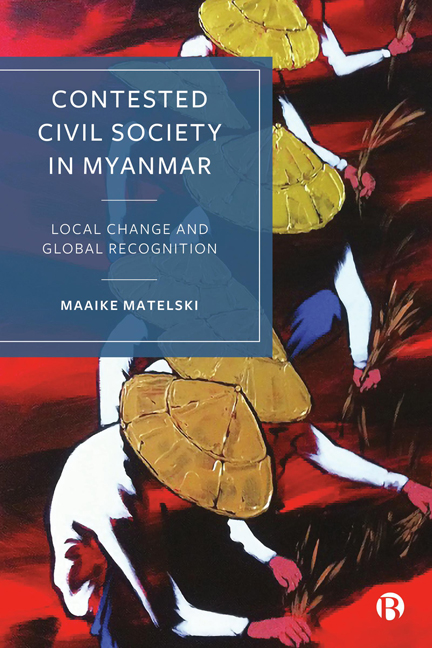Book contents
- Frontmatter
- Contents
- List of Abbreviations and Acronyms
- Acknowledgements
- Introduction: Contested Representation in Burma/Myanmar
- 1 Conflict, Repression and Resistance from Colonialism to Military Rule
- 2 Constructing Civil Society in Myanmar
- 3 Diversity and Fault Lines in Burmese Civil Society
- 4 Room to Manoeuvre under Authoritarian Rule
- 5 Transnational Advocacy Strategies and Pathways to Change
- 6 Competing Frames around the 2010 Elections
- 7 Foreign Aid and the (De)politicization of Civil Society Assistance
- 8 Interrupted Transition and Post-coup Resistance
- Conclusion
- Notes
- References
- Index
1 - Conflict, Repression and Resistance from Colonialism to Military Rule
Published online by Cambridge University Press: 28 March 2024
- Frontmatter
- Contents
- List of Abbreviations and Acronyms
- Acknowledgements
- Introduction: Contested Representation in Burma/Myanmar
- 1 Conflict, Repression and Resistance from Colonialism to Military Rule
- 2 Constructing Civil Society in Myanmar
- 3 Diversity and Fault Lines in Burmese Civil Society
- 4 Room to Manoeuvre under Authoritarian Rule
- 5 Transnational Advocacy Strategies and Pathways to Change
- 6 Competing Frames around the 2010 Elections
- 7 Foreign Aid and the (De)politicization of Civil Society Assistance
- 8 Interrupted Transition and Post-coup Resistance
- Conclusion
- Notes
- References
- Index
Summary
With the exception of 2011–20, Burma/Myanmar has the questionable honour of being the longest running military dictatorship in the world. The consecutive military governments that came to power in 1962 and 1988 were each known for their severe human rights violations, and the military leadership that took power in the 2021 coup has even surpassed their violent legacies. This chapter provides a brief historical overview, explaining how contestations over territory, political structures and ethnic minority rights have been recurring since before colonial independence and provided a motive for the military to continue its rule. Pre-existing tensions as a result of ethnic diversity had been exacerbated during British colonialism, which ended in 1948, and were far from solved when a military coup in 1962 brought an end to the recently established parliamentary democracy. Nationalist sentiments intensified as ethnic nationalities struggled for self-determination, while Buddhist nationalism also surfaced periodically, re-appearing in the course of the political transition period that started in 2010. Respective periods of nation building resulted in both extensive military rule and the search for a Burman Buddhist identity at the expense of indigenous minorities.
British colonialism and nationalist resistance
Between 1824 and 1886, the British took control of the territory now known as Myanmar during three Anglo-Burmese wars and engaged in violent pacification campaigns towards the local population. The Burmans, in turn, had come to dominate the earlier inhabitants of the territory, including the Karen and the Mon (Harvey, 1925; Lieberman, 1984). Burma initially became part of British India and from 1937 was a separate colony. In their efforts to formally map territorial boundaries, the British brought together a number of previously unaffiliated ethnic and linguistic groups. A division was created between the central area inhabited by the majority Burman population and the current ethnic states in the border areas, where bureaucratic rule by the British remained largely absent. The colonizers brought in staff for administrative positions from elsewhere and treated Burma as a less advanced and less profitable part of British India, which increasingly upset the Burmese population. In her book Making Enemies, Mary Callahan (2003) describes how the indigenous population was treated as an internal threat to colonial rule rather than inhabitants entitled to protection and inclusion in institution building.
- Type
- Chapter
- Information
- Contested Civil Society in MyanmarLocal Change and Global Recognition, pp. 17 - 30Publisher: Bristol University PressPrint publication year: 2023



